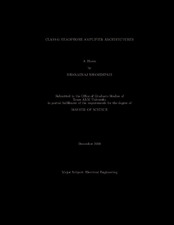| dc.contributor.advisor | Sanchez-Sinencio, Edgar | |
| dc.creator | Bhamidipati, Bharadvaj 1986- | |
| dc.date.accessioned | 2016-05-02T18:33:55Z | |
| dc.date.available | 2016-05-02T18:33:55Z | |
| dc.date.created | 2010-12 | |
| dc.date.issued | 2010-11-12 | |
| dc.date.submitted | December 2010 | |
| dc.identifier.uri | https://hdl.handle.net/1969.1/ETD-TAMU-2010-12-8760 | |
| dc.identifier.uri | https://hdl.handle.net/1969.1/156318 | |
| dc.description.abstract | To maximize the battery life of portable audio devices like iPods, MP3 players
and mobile phones, there is a need for audio power amplifiers with low quiescent
power, high efficiency along with uncompromising quality (Distortion performance/
THD) and low cost. Despite their high efficiency, Class-D amplifiers are undesirable
as headphone drivers in mobile devices, owing to their high EMI radiation,
additional costs due to filtering required at the output and also their poor linearity
at small signal levels. Almost all of todays headphone drivers are Class-AB linear
amplifiers, with poor efficiencies.
Here we propose a Class-G linear amplifier, which uses rail switching to improve
efficiency. It can be viewed as a Class-AB amplifier operating from the lower supply
and a Class-C amplifier from the higher supply. Though the classical definition of
efficiency using full-scale sine wave does not show much improvement for Class-G
(85.9 percent) over Class-AB (78 percent), we demonstrate that the Class-G audio amplifiers can
have significant improvement of efficiencies (battery life) in the practical sense. By
considering the amplitude distribution of audio signals a new realistic definition of
efficiency has been proposed. This definition helps in demonstrating the advantage
of using Class-G over Class-AB and also helps in optimizing the choice of supply
voltages which is critical to maximizing the efficiency of Class-G amplifiers.
Two new circuit topologies have been proposed and thoroughly investigated.
The first circuit is more like a developmental stage and is designed/fabricated in
AMI 0.5um. The second proposed Class-G amplifier with modified Class-AB bias,
implemented in IBM 90nm, achieves -82.5dB THD N by seamless supply switching
and uses the least reported quiescent power (350 mu W) and area (0.08mm^2). | en |
| dc.format.mimetype | application/pdf | |
| dc.subject | supply switching | en |
| dc.subject | amplitude distribution function | en |
| dc.subject | crest factor | en |
| dc.subject | true efficiency | en |
| dc.subject | instantaneous efficiency | en |
| dc.subject | headphone driver | en |
| dc.subject | output stage | en |
| dc.subject | audio amplifier | en |
| dc.subject | Class-AB | en |
| dc.subject | Class-G | en |
| dc.title | Class-G Headphone Amplifier Architectures | en |
| dc.type | Thesis | en |
| thesis.degree.department | Electrical and Computer Engineering | en |
| thesis.degree.discipline | Electrical Engineering | en |
| thesis.degree.grantor | Texas A & M University | en |
| thesis.degree.name | Master of Science | en |
| thesis.degree.level | Masters | en |
| dc.contributor.committeeMember | Toliyat, Hamid A | |
| dc.contributor.committeeMember | Palermo, Samuel | |
| dc.contributor.committeeMember | Walker, Duncan Henry M | |
| dc.type.material | text | en |
| dc.date.updated | 2016-05-02T18:33:55Z | |


